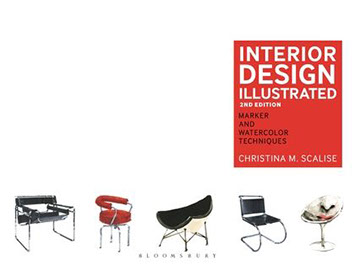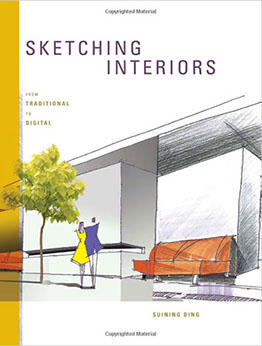DESN 130 — DESIGN DRAWING FOR INTERIORS I | FALL 2019 | T/TH 4:00–6:45PM | ROOM #
10 Things that Require ZERO Talent
1. Being on time
2. Work ethic
3. Effort
4. Body Language
5. Energy
6. Attitude
7. Passion
8. Being coachable
9. Doing extra
10. Being prepared
“The greater danger for most of us lies not in setting our aim too high and falling short; but in setting our aim too low, and achieving our mark.”
—Michelangelo
1.0 PREREQUISITES
1.1 No Prerequisites Required.
1.2 Letter grade only (A—F).
1.3 This is defined as a 6 hour laboratory class.
2.0 COURSE DESCRIPTION AND OBJECTIVES
2.1 This is a Professional Degree Program. Students in this class are expected to take their work and time here seriously, professionally
as it is a critical component of their degree.
2.2 This course is a comprehensive introduction to the fundamentals of perspective drawing and an introduction to basic rendering theory
and technique.
2.3 We will cover the basic elements of design including color theory,
line, shape, surface and volume in addition to the principles of design communication. The goal of this course is to provide a foundation
of basic design terms and concepts.
2.4 It is a project-based learning environment in which students will learn specific design drawing skills.
2.5 This class is a Professional Degree course. The high level of work expected is in order to produce Portfolio Worthy work for Acceptance
into the Upper Division, BS and BFA programs.
In other words, this is a drawing class.
Saul Bass' advice to Design Students, "Learn to draw"
3.0 EXPECTED STUDENT LEARNING OUTCOMES (SLOs)
3.1 Upon successful completion of the course, the student will have:
3.1.1 A. Developed a foundational understanding and application of perspective drawing systems for design communication,
3.1.2 B. Learned to incorporate gray scale rendering values and theory using traditional (markers, pencils, ink, pastels, etc.) and/or digital media (Photoshop, Sketchbook Pro, or similar) to
convey visual concepts and/or ideas,
3.1.3 C. Learned the art of rendering to represent a variety of
materials, textures, and surface qualities using traditional
and/or digital media,
3.1.4 D. Will learn about the mechanics for Shadow Casting, Light
Logic for Rendering, and mirror reflections,
3.1.5 E. Used both technical drawing and/or design sketching as
an integral stage in concept exploration,
3.1.6 F. Developed critical thinking and time-management skills
for design production.
4.0 CLASS PARTICIPATION AND ATTENDANCE
4.1 It is impossible to do well in this class without regular attendance. Here's why. In-class Demonstrations are given at the start of each project as well as throughout the project life-cycle. An extensive amount of content is delivered and demonstrated each day. DO NOT UNDERESTIMATE THIS. It is imperative you come to class, are on time, and utilize your time effectively, or you will not keep up. Here's how quickly it all goes:
We have 31 total sessions this semester, minus day one and the Final, we are left with 29 days. Subtracting 2 holidays, we are down to 27 sessions. If we cover 5 projects, there will be 5 days devoted to Pinup Presentation Feedback, leaving just 22 working days to present new content and provide one-on-one assistance, or about 4.4 class days per project. It'll go FAST!
4.2 Your success will depend a great deal on how effectively you utilize
class time. It is the best time to ask questions, get immediate resolution and clarifications, and move forward efficiently with minimal frustration.
4.3 It is highly encouraged that you do as much work as possible
during class.
4.4 It is highly encouraged that you work with friends and share knowledge outside of class as well.
4.5 Everyone learns differently. Have a buddy-partner you can
collaborate with.
4.6 Expect a lot of homework each week, especially when combined
with your other design classes. Do not procrastinate! Do not fall behind. Perspective and rendering projects should be an enjoyable process and is very rewarding when enough time, effort, and consideration is put
into it.
4.7 You CANNOT do all your work during class only. Department and University expectations are that you will spend a MINIMUM of 2x the class time, outside of class each week. We are in class for 5.5 hours
each week, which translates to an expected 11 hours each week outside of class. http://web.csulb.edu/divisions/aa/catalog/2016-2017/academic_information/student_unit_load.html
4.8 Do not wait to the last night before an assignment is due to work on the project or ask questions, as you may have questions and it will be too late to receive answers and/or assistance.
4.9 If you are going to miss a class where an assignment is given make sure to ask the instructor or a classmate for the additional information. Make friends and share contact information with one another. It is the student’s responsibility to make up missed assignments.
4.10 Attendance is taken every day using Beachboard. The percentage
of attendance is calculated as your Participation & Attendance grade (See 6.2.4).
4.11 Being more than 15 minutes late or leaving early may result in being unaccounted for, ie. absence.
4.12 Students are allowed three permitted absences for emergencies, unexpected needs, and/or circumstances beyond their control as defined by the university (http://web.csulb.edu/divisions/aa/catalog/2016-2017/academic_information/class_attendance.html). It is not necessary to provide an explanation of your absence(s) to the instructor.
4.13 The instructor may require students to provide documentation for excused absences. Valid excuses, defined by the university, include illness or injury to the student; death, injury, or serious illness of an immediate family member or the like; religious reasons; jury duty or government obligation; University sanctioned or approved activities (examples include: artistic performances, forensics presentations, participation in research conferences, intercollegiate athletic activities, student government, required class field trips, etc.).
5.0 WITHDRAWAL POLICY
5.1 It is the student’s responsibility to withdraw from this course, if so desired. Instructor does not drop anyone. Withdrawal from the course after the deadline is granted only under extenuating circumstances.
5.2 Doing poorly is not an extenuating circumstance, per department policy.
5.3 See the University Website for critical registration and withdrawal dates.
www.csulb.edu/depts/enrollment/dates/
6.0 PROJECT VALUES AND GRADING SCALE
6.1 This is a Project-based Learning course. Attendance and Participation
is critical for your success.
6.2 The student's final grade is comprised of 3 metrics, they are:
6.2.1 Projects (60%)
6.2.1.1 There will be 4 to 5 primary projects. Each worth 100 points each and will be divided equally across Projects.
6.2.1.2 Projects may be broken into parts, such as Part 1 and Part 2, etc. at any time at the instructor’s discretion.
Sub-assignments will be worth 100 points, divided equally across Projects.
6.2.1.3 A pop-quiz or in-class timed exercise may be given
at any time. It will be worth 100 points. If the student misses this class the student will be able to make up
the quiz another day.
6.2.1.4 Grades are posted regularly on Beachboard with notification. Students should always know how they are doing in the class. It is the student’s responsibility to check their grades and confirm the grade given was entered correctly or any other errors were not made.
6.2.1.5 Evaluation, notes for improvements, of work is provided via verbal feedback in public Pinups at the Due date. Noes are also posted on Beachboard with each grade.
The student may always inquire for more specifics regarding their grade.
6.2.1.6 Students may turn in assignments early if they plan to
be absent on a due date. There is no bonus for turning
in an assignment early.
6.2.1.7 Late submissions are marked down 10 points for each class that it is late. After 3 class days, no additional penalty is assessed; the student’s grade would begin at
a maximum of 70%, and points for errors, etc. deducted from there, taking the grade into D or lower range. Avoid being late! However, late work will always earn some points. 50% is better than zero.
6.2.1.8 REDOs. The opportunity to "Re Do" your work for points towards grade improvement. There are NO REDOs. Invest yourself and do it well the first time and apply
the improvement going forward.
6.2.3 Final Project (20%)
6.2.4 Attendance & Participation (20%)
6.2.4.1 Includes coming every day, being on time to class, staying the full session, being prepared, conducting oneself professionally, engaging in thoughtful discourse, being engaged, showing enthusiasm, actively participating in the dialog during critiques, etc.
6.2.4.2 Be sure to inform me when you know you will be unable to attend for a university valid excuse. See 4.1.3.
6.2.4.3 Attendance is calculated based on the percentage of
total attendance, ie. 82% attendance will equal an 82.
6.2.4.4 You have an obligation to your classmates. The entire class is a working laboratory for design thinking, drawing, and discovery, ie. a “studio” of your teammates. When you show up unprepared for a pin-up, you fail to share your work with your teammates, and therefore fail to exchange in shared knowledge.
6.2.4.5 If it is a pin-up day and you cannot pin-up, you will be marked absent and/or will receive a minimum of one grade reduction. Only legitimate university excuses will be accepted for missing a presentation.
7.0 CRITERIA FOR GRADING OF PROJECTS
7.1 The following criteria is established by the university. See Final Course Grades, Grading Procedures, and Final Assessments for more details.
A = 90 + Excellence. Projects that meet all criteria, are professionally crafted and submit on time. May have minor non-critical flaws. Work which goes above and beyond expectations.
B = 80–89 Good. Projects that meet all criteria, are professionally crafted and submit on time, with a few non-critical flaws. Competent, but not exceptional.
C = 70–79 Acceptable. Projects that do not meet all criteria, or are
not professionally crafted, have considerable flaws, or are late. Marginally acceptable.
D = 60–69 Weak. Projects that do not meet all of the criteria, and
are poorly crafted, and have substantial flaws, and/or is exceptionally late.
F = 59 or less — Unsatisfactory. Failure to complete any of the above. Extremely sloppy and/or flawed.
7.2 It is the student's responsibility to understand, comprehend, and through one's work, demonstrate comprehension of the principles and concepts presented. Your work is evidence of your thoughts, your process, and your understanding of the assignment principles. This is your job!
7.3 "I tried my best" has no bearing on the quality of your work. Similarly,
the amount of time you spent does not determine the quality of your
end product. You may need to work twice or three times as hard as a classmate. Your education is ultimately your responsibility.
8.0 GRADING AND EVALUATION RUBRIC
8.1 The following Rubric will apply in assessment of the student's work product, presentation, and/or process on all assignments, sketchbooks, and/or in-class quizzes:
9.0 PENALTIES FOR ACADEMIC DISHONESTY
9.1 Violations of the university policy can result in a failing grade of “F”
for this course and/or other sanctions. Plagiarism, taking credit for someone else’s work, is one of many forms of academic dishonesty.
9.2 See the General Policies and Regulations section in the University Catalog for more information.
9.3 Your work MUST be your work. If it you regularly do not work during class, then show up with amazing work with little evidence that you
have worked on it I may have initiate an investigation, have you take
an "evidence" quiz, or take other measures.
10.0 SUBMISSIONS
10.1 On Project due dates, pin-up your project at the start of class for
verbal feedback and discussion.
10.2 Work may or may not be collected for placing on display.
10.3 Photographic documentation is done by the instructor, making it unnecessary for students to submit a CD/flash drive/etc. of their
work at the end of the semester (or Summer session).
11.0 ACCOMMODATION
11.1 Students with a disability or medical restriction who are requesting a classroom accommodation should contact the Disabled Student Services at 562-985-5401 or visit Brotman Hall, Suite 270 during 8AM-5PM weekday hours. Disabled Student Services will work with the student to identify a reasonable accommodation in partnership with appropriate academic offices and medical providers. We encourage students to reach out to DSS as soon as possible.
12.0 CLASSROOM ENVIRONMENT
12.1 The classroom is a place of learning. Please show respect for others
with your speech, volume, behavior, work area tidiness, attire, attitude, and use of electronic devices.
12.2 NO Headphones. Period. Even during work sessions. Daily there are topics that arise and you will need to listen. I do not care to shout to you get your attention. You need to listen to conversations around you that WILL BE relevant to your learning and work. It is imperative that you check in, not out.
12.3 Phone calls and texting are not allowed in the classroom. Take calls outside. If your texts are vitally important, then step out.
12.4 Please turn the ringer off on your phones before class.
12.5 Laptops are allowed during lab time ONLY if used for research purposes or as an assignment warrants.
12.6 Anyone found taking a test for another class during my class time, is not only blatantly disrespecting me personally, but neglecting their own work. You will be immediately rejected from class and marked absent for the day. No exceptions.
12.7 Bring your textbook to class to read, study, and/or sketch from to better understand project related content.
13.0 HEALTH AND SAFETY AWARENESS
13.1 Take safety very seriously. You do not want to get injured nor see your friend need to get rushed to the hospital in the middle of the night.
13.2 Use common sense. Many art supplies can be toxic or dangerous.
Read labels and use your supplies in a responsible and healthy way. Please do not use spray adhesives on your projects.
13.3 X-acto blades and similar cutting blades (even a sharp, hard lead pencil) are extremely sharp and can cause severe injury. Use caution when carrying and using them. Blades should be kept at a low angle when cutting. Ask me to demonstrate. If you have any questions, ask the instructor for demonstration of the safest technique(s).
13.4 CAUTION and PATIENCE when cutting. SLOW DOWN, no matter
when your deadline is.
14.0 BEACHBOARD, COMMUNICATION, AND EMAIL POLICY
14.1 The course syllabus and assignments will be available on Beachboard.
It is the student’s responsibility to access Beachboard and print the projects before each is introduced in class. Students are accountable
for comprehending written and verbal instructions and clarifications to projects. Each project will be explained in class where further detail
and examples will be given.
14.2 Communication is highly encouraged and expected for success. Responses will be made in as timely a manner as possible in order to keep the student moving forward. However, immediate replies should
not be expected, but will be honored within 24 hours. Responses should not be expected during off hours or during holiday breaks, but you will find I will usually reply normally very quickly.
14.3 Responses will not be provided to material that was clearly covered during class for someone who was late to class, left early, or failed to attend. However, if a substantial number of students have the same or similar questions, these will be posted to the Beachboard blog.
14.4 Inappropriate e-mail is subject to university policy.
15.0 COURSE TEXTS AND REFERENCES
15.1 COURSE MATERIALS LIST CAN BE FOUND HERE
15.2 Every designer builds a personal library for their reference and development of their personal Visual Library—the stored visual references in your memory. The following books will benefit your drawing ability for years.
15.3 The latest edition is not necessary. Used books are just as good as new, so save money and buy older editions if necessary, or check them out from the Library.
15.4 I recommend traditional print over e-books; e-books are easier to carry around, but far more difficult to flag, note, and learn from, and they are easier to resell should you so choose.
15.5 Many e-books are available from: iTunes Store; Kindle Store; and CourseSmart.

Perspective and Sketching for Designers. Jessica Newman, Jack Beduhn. Pearson Publishing. Text alone ISBN 0-13-257494-2; Text with online resource pass card ISBN 0-13-301205-0, is not required but you may find it helpful.
FREE DOWNLOAD!

Interior Design Illustrated: Marker and Watercolor
Techniques. Christina M. Scalise. Bloomsbury Publishers. ISBN-13: 978-1609019174

Sketching Interiors: From Traditional to Digital by Suining Ding. Fairchild Books. ISBN: 978-1-56367-918-6
^
* Estimate only. See instructor and calendar for specific due dates. Summer Session schedule is more compressed with one week equal to approximately two and half semester weeks.
CSULB | COTA | DEPARTMENT OF DESIGN | BIO

Questions, feedback, suggestions?
Email me with your recommendations.
©2020 Michael LaForte / Studio LaForte, All Rights Reserved. This site and all work shown here is purely for educational purposes only. Where ever possible student work has been used or original works by Michael LaForte.
Works by professionals found online or in publication are used as instructional aids in student understanding and growth and is credited everywhere possible.
